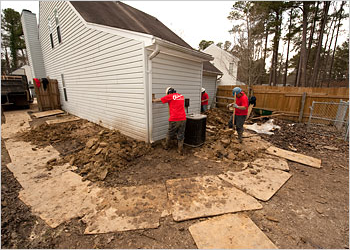Extreme weather causing U.S. home foundations to fail
By KATE MURPHY
Published: March 3, 2010 STEVEN DERSE, the owner of a corporate travel business in Nashville, cannot feel his house move, but he can hear it. “It’s an eerie creaking sound,” he said, and it echoes throughout his two-story Georgian-style house. It started two years ago when a severe drought contracted the soil beneath the foundation, which caused it to crack and sink, pulling the house down with it. The noise has continued intermittently, becoming more insistent last year when flooding pushed the already compromised foundation and house back upward. This seesawing effect was noisy and expensive. Mr. Derse has spent more than $10,000 to install subterranean piers to stabilize his foundation, and he expects he will have to install more to prevent further cracking and crumbling. “You lose your sense of security,” he said. “You love your home and then it literally turns on you.” His is not the only house buffeted by shifting soil. Extreme weather possibly linked to climate change, as well as construction on less stable ground, have provoked unprecedented foundation failures in houses nationwide. Foundation repair companies report a doubling and tripling of their business in the last two decades with no let-up even during the recession “We’ve seen a tremendous influx of pretty severe cases due to either drought or too much rain,” said Dan Jaggers, vice president of technical services at Olshan Foundation Repair, which has offices in the South, Midwest and Great Plains. “People call panicked because they’ve got gaping cracks in their walls, tile breaking, grout popping and they don’t know what to do.” Other telltale signs of foundation failure include doors and windows that will not close, chimneys or porches separating from the house and bowing basement walls. After a particularly dry summer followed by deluges in the fall, Psonya Wilson, a lawyer in Brandon, Miss., noticed light streaming in where the wall had separated from the baseboard in the bedroom of her 5-year-old son. “I could stick my finger through it,” she said. “I couldn’t believe it. The whole back part of the house had sunk about six inches.” To stop further collapse, not to mention to control the draft, she is having several stabilization piers installed to shore up the foundation of her two-story garden style house; it will cost more than $5,000. Data from the National Oceanic and Atmospheric Association indicates that since the 1990s there has been an accelerating trend nationwide toward more extended dry periods followed by downpours. Whether due to random climate patterns or global warming, the swings between hot and dry weather and severe rain or snow have profoundly affected soil underneath buildings. …
